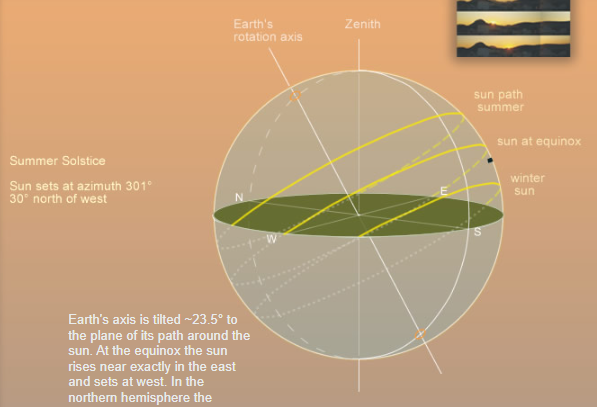OPOD - A year of sunsets, Greece
OPOD - A Year of Sunsets in Greece
Have you ever noticed how the position of the sunset changes throughout the year? The previous OPOD (Optics Picture of the Day) gave us a glimpse of the sunset point moving northwards near the spring equinox. Today, we'll delve deeper into this fascinating phenomenon and explore the year-long journey of sunsets in Greece.
Anastasios Nezis, a keen observer and photographer, captured the beauty of sunsets every two weeks from the Greek Island of Salamis, near Athens. Through his photographs and videos, we can witness the gradual movement of the sunset point over the course of a year.
At the start of the sequence, during the spring equinox, the sunset occurs almost due west. As we progress towards the summer solstice, a sense of joy fills the air as the sunset point slowly creeps northwards, reaching its maximum travel. During this time, the days are long and filled with ample sunlight.
However, as we move beyond the summer solstice, a tinge of sadness sets in. Each passing day brings the sunset further south, and the daylight hours become shorter. The changes in sunset position are most rapid near the autumnal equinox, before gradually slowing down as we approach the maximum travel southwards, which marks the winter solstice.
On Salamis Island, located at a latitude of 38°N, the sunset point moves approximately 30° northwards between the spring equinox and summer solstice. However, as winter approaches, it slides a staggering 60° southwards to reach its position during the winter solstice. This shift in position is responsible for the significant variation in daylight hours throughout the year. During midsummer, Salamis experiences nearly 15 hours of daylight, while in midwinter, this duration shrinks to only nine and a half hours.
These seasonal changes in sunset position may seem mild when compared to locations further north or in the Arctic. In these regions, the differences between midsummer, with its endless sunlight, and midwinter, with its nonexistent sunlight, are much more pronounced.
The movement of the sunset point is a result of Earth's axial tilt of approximately 23.5° to the plane of its path around the sun. During the equinoxes, when the tilt is most aligned with the sun, the sunrise and sunset points gradually shift northwards as spring progresses. This shift contributes to the lengthening of each day. However, as we reach the summer solstice, the changes in position slow down and eventually come to a halt.
The captivating images captured by Anastasios Nezis allow us to witness the beauty and dynamics of sunsets throughout the year. From the shifting positions during the equinoxes to the extremes of summer and winter solstices, each day brings forth a unique sunset experience.
Please note that this article has been automatically converted from the old site and may not appear exactly as intended. The original article can be found here.
In conclusion, observing the movements of the sunset point over a year in Greece offers us a glimpse into the dynamic nature of our planet's relationship with the sun. As the seasons change and Earth's tilt varies, so too does the position of the setting sun. These gradual shifts bring about variations in daylight hours, shaping the rhythms of life and offering breathtaking views of nature's wonders. So, next time you witness a sunset, take a moment to appreciate the celestial dance unfolding before your eyes.

A year of sunsets
The previous OPOD showed the sunset point moving appreciably northwards in only one day near the spring equinox. Here we see sunset movements over a whole year.
Anastasios Nezis captured sunsets every two weeks from the Greek Island of Salamis near Athens. See them also in video (science videos)
Sunset almost due west at the spring equinox starts the sequence. Then, joyously, the sunset point creeps northwards reaching its maximum travel at the summer solstice. There the days are long.
Then we sadden as, each day, the sunset is that much further south and each day is a little shorter. Daily changes are most rapid near the autumnal equinox and they slow again towards the maximum travel southwards marking the winter solstice.
At Salamis's latitude of 38�N the sunset point moves 30� northwards between the spring equinox and summer solstice. Then it slides 60� south to the winter solstice. The midsummer day is nearly 15 hours long but only nine and a half hours at midwinter.
These are mild seasonal changes compared to those further north and especially in the Arctic where midsummer sunlight is endless but in midwinter nonexistent .
Images ©Anastasios Nezis, shown with permission

Earth's axis is tilted ~23.5° to the plane of its path around the sun. At the equinox the sun rises near exactly in the east and sets at west. In the northern hemisphere the sunrise and sunset points creep northwards as spring advances making each day slightly longer. The changes are most rapid at the equinox and slow to zero at the summer solstice.

Note: this article has been automatically converted from the old site and may not appear as intended. You can find the original article here.
Reference Atmospheric Optics
If you use any of the definitions, information, or data presented on Atmospheric Optics, please copy the link or reference below to properly credit us as the reference source. Thank you!
-
<a href="https://atoptics.co.uk/blog/opod-a-year-of-sunsets-greece/">OPOD - A year of sunsets, Greece</a>
-
"OPOD - A year of sunsets, Greece". Atmospheric Optics. Accessed on November 26, 2024. https://atoptics.co.uk/blog/opod-a-year-of-sunsets-greece/.
-
"OPOD - A year of sunsets, Greece". Atmospheric Optics, https://atoptics.co.uk/blog/opod-a-year-of-sunsets-greece/. Accessed 26 November, 2024
-
OPOD - A year of sunsets, Greece. Atmospheric Optics. Retrieved from https://atoptics.co.uk/blog/opod-a-year-of-sunsets-greece/.